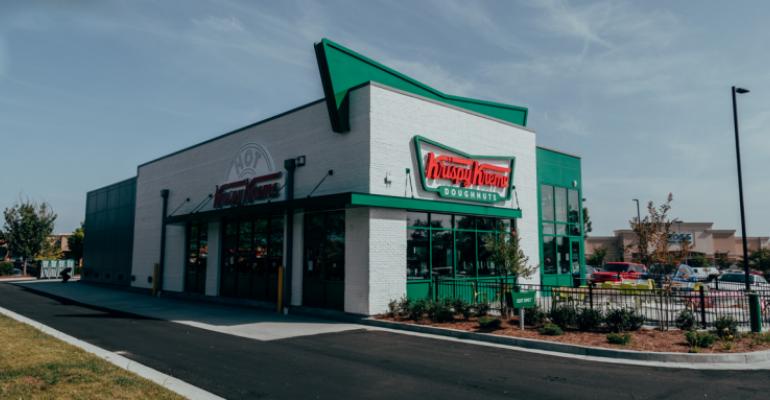During the JAB Holding-owned doughnut chain Krispy Kreme’s third earnings call after going public, the company reported significant growth momentum for the fourth quarter of 2021, attributed to strong seasonal sales and the brand’s points of access growing by 2,000 to 10,400 – with doughnut access in shops and behind grocery store doors.
“The industry likes the franchisee model, or looks at things like same-store sales, or even a company model where they keep building out more and more restaurants,” Krispy Kreme CEO Mike Tattersfield told Nation’s Restaurant News. “For us, it’s really about building 10,000 points of access today. That was the number one issue we had with customers: they didn't have access to our brand. So instead of saying, ‘let's build a whole bunch of donut shops everywhere,’ we think: ‘Why don't we figure out a fresh distribution model?’”
Tattersfield calls it the “hub and spoke” model, where the doughnut shops are the hub and the spokes are grocery stores, convenience stores, etc. and fresh doughnuts are baked fresh every day and distributed to the “spokes.”
Krispy Kreme doesn’t mind being “the odd one out” by focusing on a less-than-traditional growth model. For example, whereas many foodservice brands in the industry are starting to turn to ghost kitchens, Tattersfield does not think that fits the Krispy Kreme growth strategy. Instead, he sees them in more what he calls “dark shops,” which act as pickup points for delivery drivers. Krispy Kreme shops bake the doughnuts and drop them off to these dark shops that are not accessible to the public, which can expand delivery zones and cut down on delivery times. Tattersfield said the brand started testing out dark shops in London and will soon bring them to urban markets in the U.S.
Another differentiator, he added, is Krispy Kreme’s comfort with staying in its own lane: he said that the brand does not want to expand its menu into new categories or compete with Dunkin’ to become the next big coffee shop brand that also happens to sell doughnuts.
“This is who we are: we don't actually want to be a coffee company,” he said. “We're not really interested in trying to do sandwiches throughout the day […] If you want to be the most loved sweet treat brand in the world, you need to stick with sweet treats.”
Moving forward, Tattersfield wants to continue to raise awareness of the brand for new customers and increase occasions for returning customers, with similar specials to the vaccination special they did last year, which offered customers one free original glaze doughnut every day if they show their vaccine card.
“We’ve evolved the brand from just a doughnut shop to an experiential consumer packaged goods company,” he said.
Of course, you can always expect new doughnuts flavors coming down the pipeline, like the new limited-edition Twix doughnuts that were released on Feb 21 and are stuffed with Twix candy bars and caramel icing.
Krispy Kreme’s net income for the fourth quarter of 2021 ended Jan. 2, 2022 was $4.3 million or $0.01 earnings per share, up from a loss of $24.8 million or down $0.21 cents per share the same quarter the year prior.
Contact Joanna Fantozzi at [email protected]
Follow her on Twitter: @joannafantozzi





